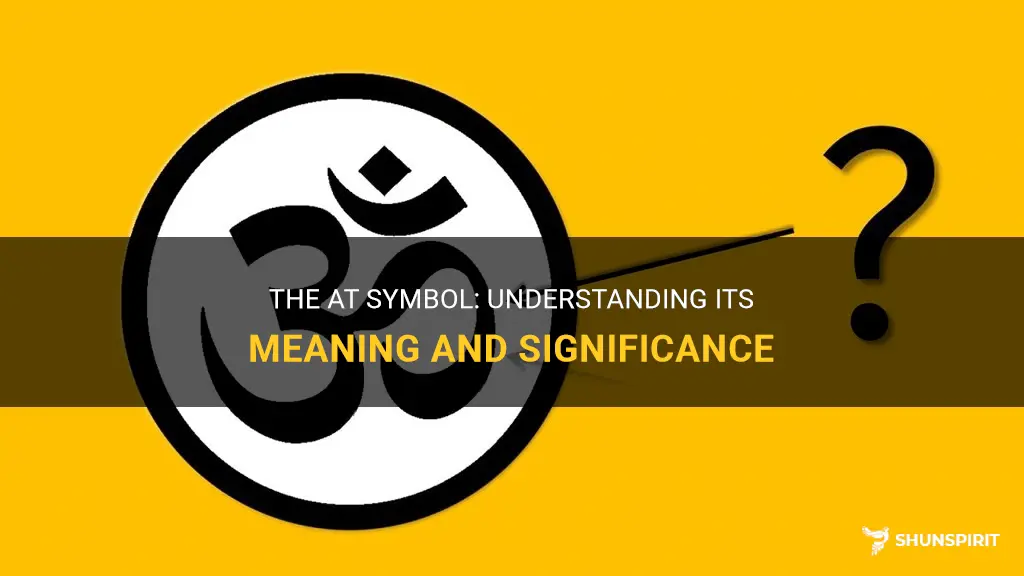
The at symbol, '@', is a unique and intriguing character that has become a ubiquitous part of our digital communication. Originating as a humble symbol in accounting and commerce, it has now become a powerful symbol representing connectivity, communication, and the modern era of technology. Whether used to signify email addresses, social media handles, or even as a shorthand in various programming languages, the at symbol has taken on multiple meanings and roles in our digital world. In this article, we will explore the history, evolution, and significance of the at symbol, shedding light on its remarkable journey from humble beginnings to its current role as a symbol of connection in the digital age.
What You'll Learn
- What does the @ symbol mean in an email address?
- What is the significance of the @ symbol in social media handles?
- How is the @ symbol used in programming or coding languages?
- What does the @ symbol represent in online usernames or screen names?
- In mathematics, what does the @ symbol represent when used in intervals or intervals of values?

What does the @ symbol mean in an email address?
The @ symbol is an essential component of every email address, and it serves a critical purpose in the world of communication. Without the @ symbol, it would be impossible for emails to reach their intended recipients. So, what exactly does the @ symbol mean in an email address?
In an email address, the @ symbol is used to separate the username or mailbox name from the domain name. The username typically signifies an individual or organization, while the domain name represents the email service provider or company.
Before the widespread use of email, the @ symbol was mainly used in accounting and commerce to represent "at the rate of" or "at the price of." However, in 1971, computer scientist Ray Tomlinson chose the @ symbol to separate the user's name from the destination address while developing the first email system. He needed a symbol that was not already used in naming conventions and found that the @ symbol made the most sense.
The @ symbol holds such significance because it acts as a delimiter to identify the specific location where an email should be sent. It tells the email client or server that the content of the email is intended for the user specified before the @ symbol, on the domain specified after it. Without this symbol, the email system would not know where to route the email or who the intended recipient is.
For example, in the email address "[email protected]," "johndoe" is the username or mailbox name, while "gmail.com" is the domain name. The @ symbol separates these two components and directs the email to the Gmail email service, where the mailbox for "johndoe" is located.
Furthermore, the @ symbol is now a universally recognized icon for email. It has become synonymous with electronic communication and is widely used in email-related logos, branding, and advertising.
It is important to note that the @ symbol has become so popular that it is often used in other contexts on the internet. For instance, on social media platforms, the @ symbol is used to mention or tag other users. In this case, it serves a similar purpose by directing a message or notification to a specific individual or account.
In conclusion, the @ symbol in an email address is essential for the proper functioning of email communication. By separating the username from the domain name, it enables emails to be directed to the intended recipient's mailbox. Thanks to computer scientist Ray Tomlinson's choice in 1971, the @ symbol has become a universal symbol for email and is recognized worldwide as a symbol of communication.
Exploring the Rich Symbolism of Ghana: Unveiling the Hidden Meanings of Ghanaian Symbols
You may want to see also

What is the significance of the @ symbol in social media handles?
In the ever-evolving world of social media, the symbol "@" has become a ubiquitous part of our online lives. From Twitter to Instagram, Facebook to LinkedIn, the "@" symbol is used to tag and mention other users in posts and comments. But have you ever wondered what the significance of this symbol is? Let's delve into the origins and significance of the "@" symbol in social media handles.
The "@" symbol, also known as the "at sign" or "at symbol," has a rich history that predates the internet and social media by several decades. It was first introduced in commerce and accounting in the late 19th century and was primarily used to indicate "at a rate of" or "at the price of." For example, if something was priced at $10 per unit, you would write it as 10@$/unit.
However, it wasn't until the invention of email that the "@" symbol gained widespread recognition and usage. In the early 1970s, Ray Tomlinson, the inventor of email, chose the "@" symbol to separate the recipient's username from their domain name. This decision was largely arbitrary, as Tomlinson needed a character that was not commonly used in email addresses.
Fast forward to the rise of social media platforms in the late 2000s, and the "@" symbol found its way into the hearts and minds of millions of users. Its primary function is to tag and mention other users in posts and comments, effectively creating a link between their profile and the content being shared. By including the "@" symbol before a username, users can ensure that the mentioned person receives a notification and can easily navigate to the content in question.
The use of the "@" symbol in social media handles has several significant implications. Firstly, it facilitates communication and connection between users. Whether it's thanking a friend for a birthday wish, engaging in a public conversation with a celebrity, or seeking customer support from a brand, the "@" symbol allows users to directly address and involve specific individuals or entities.
Secondly, the "@" symbol helps in building communities and fostering engagement. Many platforms, such as Twitter, make use of hashtags and mentions to create trending topics and threads. By using the "@" symbol, users can alert others to join the conversation and participate in a collective discussion.
Furthermore, the "@" symbol is a powerful tool for brands and businesses. It enables them to engage with their audience, respond to customer queries, and even collaborate with influencers or brand ambassadors. By mentioning their handle in posts, users can amplify and spread their content, increasing visibility and reach.
It's worth noting that the "@" symbol has also become synonymous with user identification and recognition. In some cases, individuals may use the symbol in their social media handles as a way to express their online persona or affiliation. For example, a person named John Smith might choose the handle @johndoesmith to differentiate themselves from other John Smiths.
In conclusion, the "@" symbol in social media handles has evolved from its humble origins in commerce and accounting to become an integral part of online communication and engagement. Its functionality in tagging and mentioning other users has revolutionized how we connect and interact on social media platforms. Whether for personal interactions, community engagement, or brand communication, the "@" symbol plays a significant role in shaping the digital landscape. So next time you see the "@" symbol, remember its rich history and the power it holds in connecting people across the globe.
Understanding School Bus Dashboard Symbols: What Do They Mean?
You may want to see also

How is the @ symbol used in programming or coding languages?
The @ symbol plays a significant role in various programming and coding languages. It is often used as a prefix or operator with specific meaning and functionality. Let's explore some of the common uses of the @ symbol in programming.
Email Address or Annotations:
In many programming languages, the @ symbol is primarily used to denote email addresses or annotations. For example, in Python, an email address might be represented as "[email protected]". Additionally, some programming languages, like C#, use the @ symbol to ignore escape sequences within string literals. It can be helpful when dealing with file paths or regular expressions, as it enables programmers to write strings without having to escape backslashes or other special characters.
Decorators in Python:
Python uses the @ symbol as part of its decorator syntax. Decorators are a way to modify the behavior of functions or classes at the time of definition. They are denoted by the @ symbol followed by the decorator name, which is typically a function. Decorators allow programmers to add functionality to existing code without modifying it directly. They are commonly used for aspects such as logging, authentication, or performance optimization.
Language-Specific Syntax:
The @ symbol may have language-specific uses and syntax in various programming languages. For instance, in Java, the @ symbol is used for annotations, which are meta-data that provide additional information about a class, method, or variable. These annotations can be used by tools or frameworks to generate code, configure runtime behavior, or perform other automated tasks.
String Interpolation:
In some programming languages, such as C#, the @ symbol is used for string interpolation. String interpolation allows programmers to embed expressions within string literals by using placeholders. The @ symbol precedes the string literal and changes the escape character from the backslash to the at sign. This makes it easier to include variables or expressions directly within the string without the need for complex concatenation or formatting.
Instance and Class Variables:
In certain programming languages, like Ruby, the @ symbol is used to denote instance and class variables. Instance variables belong to a specific object or instance, while class variables are shared across all instances of a class. The @ symbol serves as a convention to indicate that a variable is an instance or class variable, helping programmers distinguish them from local variables or method parameters.
In summary, the @ symbol serves various purposes in programming and coding languages. Whether it denotes email addresses, annotations, decorators, or specific language syntax, the @ symbol plays a crucial role in enhancing functionality, readability, and expressiveness within the codebase. Understanding its usage in different contexts is essential for proficient coding.
Decoding the Hidden Language: Unveiling the Meaning Behind Text Symbols
You may want to see also

What does the @ symbol represent in online usernames or screen names?
The @ symbol has become synonymous with online communication, particularly in the realm of social media. It is most commonly associated with usernames or screen names on platforms such as Twitter and Instagram. But what does the @ symbol actually represent in these contexts?
In the world of online usernames, the @ symbol is often used to identify a particular individual or account. It is used to tag or mention someone in a post or comment, notifying them that they have been included in the conversation. For example, if a user wants to direct a comment or message to another user, they would include the @ symbol followed by the person's username. This creates a link to their profile and alerts them to the mention.
The use of the @ symbol in this way is known as a "mention" or "tag." It allows users to easily reference and interact with others on social media platforms. It is particularly useful for engaging in discussions, acknowledging someone's contributions, or addressing them directly.
On platforms like Twitter, the @ symbol is also used to create a reply or conversation thread. When a user replies to a tweet, the original tweet is often quoted and the username of the person being replied to is prefixed with the @ symbol. This helps to keep the conversation organized and allows users to easily follow the thread of replies.
In addition to its use in usernames and conversations, the @ symbol also has an important function in email addresses. It separates the username from the domain name, indicating where the email should be delivered. For example, in the email address [email protected], "john.doe" is the username and "example.com" is the domain name.
Overall, the @ symbol plays a crucial role in online communication by allowing users to easily mention or tag others in social media posts and comments. It is a simple yet powerful way to connect and interact with others in the digital world.
The Meaning and Importance of Legal Symbols
You may want to see also

In mathematics, what does the @ symbol represent when used in intervals or intervals of values?
In mathematics, the "@" symbol is commonly used to represent intervals or intervals of values. It is often referred to as the "at" symbol or the "around" symbol.
When used in intervals, such as in set notation or interval notation, the "@" symbol denotes the inclusion of the endpoints of the interval. This means that the values at the endpoints are considered part of the interval. For example, if we have an interval written as [a, b], where a and b are real numbers, the "@" symbol indicates that both a and b are included in the interval.
To further clarify, let's consider some examples:
- [2, 5] - This interval includes the numbers 2 and 5. In interval notation, this can also be written as 2 ≤ x ≤ 5, where x represents any value contained within the interval.
- (-∞, 3] - This interval includes all real numbers less than or equal to 3, including 3. The symbol "-∞" represents negative infinity, indicating that the interval extends indefinitely in the negative direction.
- [0, ∞) - This interval includes all real numbers greater than or equal to 0, but does not include infinity. The symbol "∞" represents infinity, indicating that the interval extends indefinitely in the positive direction.
It's important to note that the use of the "@" symbol in intervals can vary slightly depending on the specific notation system being used. For example, in some contexts, the "@" symbol may be used to indicate open intervals, where the endpoints are not included. However, this usage is less common and can often be clarified by additional notation or context.
In conclusion, the "@" symbol in mathematics is commonly used to denote intervals or intervals of values. When used in this context, it indicates that the endpoints of the interval are included. Whether in set notation or interval notation, the "@" symbol helps to define the range of values that are considered part of a particular interval.
The Meaning behind the Olympic Symbol: Uniting the World through Sport
You may want to see also
Frequently asked questions
The "at" symbol, also known as the at sign or @, is used in email addresses to separate the user name from the domain name. For example, in the email address [email protected], the "at" symbol is used to separate "john" (the user name) from "example.com" (the domain name).
In social media handles, the "at" symbol is used to indicate a user's handle or username. It is commonly used on platforms like Twitter and Instagram. For example, a Twitter handle might be @johnsmith, where the "at" symbol is used to directly refer to the user's handle.
In programming, the "at" symbol has various uses depending on the programming language. In some languages, like PHP, it is used as a symbol for accessing object properties or methods. In regular expressions, the "at" symbol is used to match a specific character. Additionally, in some programming languages, like Perl, the "at" symbol is used to suppress warning messages.







